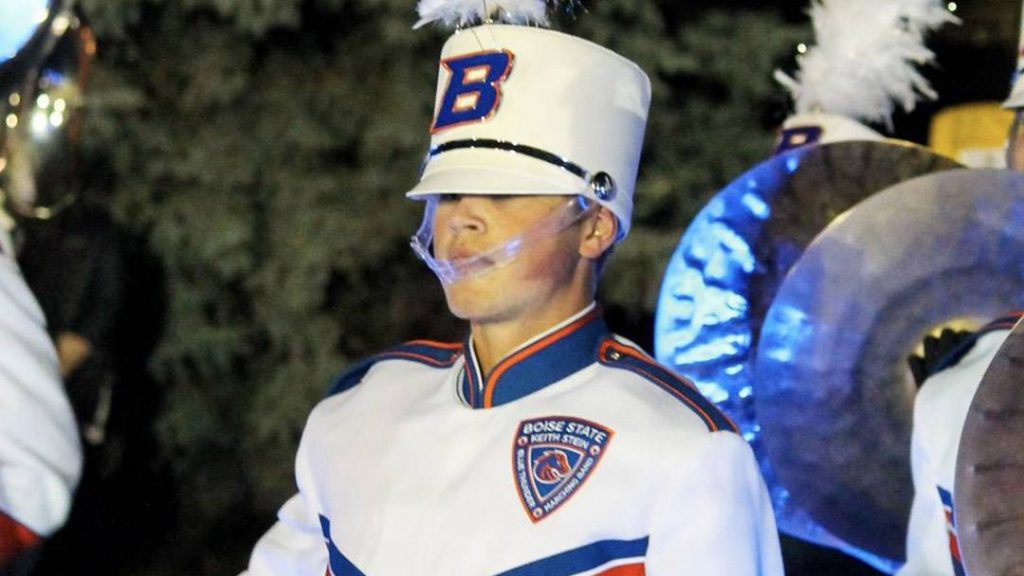-
Sharing Mayo Clinic: Marching to the beat of his own drum after brain surgery

Tanner Effinger knew something was seriously wrong. Despite seeing multiple physicians in Virginia and Idaho, no one could figure out what was causing his weight loss, fatigue and anemia. Within days of arriving at Mayo Clinic, however, Tanner was diagnosed with an unusual brain tumor. After it was surgically removed, all of Tanner's symptoms disappeared.
When Tanner Effinger arrived at Mayo Clinic in April 2018 following nearly a year of increasingly severe symptoms, including weight loss, anemia, extreme fatigue and headaches, the college sophomore had no idea he would undergo brain surgery four days later.
But after Tanner saw physicians at Mayo Clinic's Rochester campus in the departments of Gastroenterology, Hematology, Neurology, Oncology and Rheumatology, he was diagnosed with a tumor in the right frontal lobe of his brain. The diagnosis led to surgery to remove the tumor that eliminated his symptoms and turned his life around.
Terence Burns, M.D., Ph.D., Tanner's neurosurgeon, attributes much of Tanner's swift, successful outcome to the way Mayo Clinic works.
"That Tanner arrived with fatigue, anemia and suspected celiac disease, was evaluated by specialists from half a dozen disciplines all working together to solve a puzzle, and then was back home cured after brain surgery within a week is a reflection of Mayo's teamwork and efficiency," Dr. Burns says. "It's one of the special things about Mayo that empowers us to take the best possible care of truly unique patients like Tanner."
Strange symptoms
Tanner's symptoms began during summer 2017 after his freshman year at Old Dominion University in Norfolk, Virginia, where he was a mechanical engineering major. After returning from a trip to Walt Disney World with the university's marching band, he lost 15 pounds in just one week. As the summer progressed, he frequently felt extremely fatigued.
The 19-year-old percussionist went to his primary care doctor for a full workup and learned he had severe anemia. A referral to a gastroenterologist who performed an endoscopy led to a diagnosis of celiac disease. The doctor also told Tanner that test results showed his inflammatory markers were high, but the reason for that result wasn't clear.
"I was starting to suffer academically because I was constantly going to doctors' appointments. … I was having a lot of anxiety and depression over all these medical issues."
Tanner Effinger
Despite following a gluten-free diet to ease celiac disease, Tanner's symptoms worsened, and he continued to lose weight. Around Halloween, his hemoglobin count was so low that he required a double blood transfusion.
"I was starting to suffer academically because I was constantly going to doctors' appointments. Around early November, one of my professors came up to me after class and said if I missed any more class, I would have no chance at passing," Tanner says. "I was having a lot of anxiety and depression over all these medical issues."
Tanner withdrew from college, and he moved with his parents to Idaho at the end of 2017. But his medical concerns continued. In addition to Tanner's other symptoms, what had been mild headaches became excruciatingly painful migraines in early 2018. Doctors in Boise couldn't find the cause of his symptoms, so Tanner and his parents decided to schedule an appointment for him at Mayo Clinic's Rochester campus.
Bizarre tumor
After they arrived at Mayo Clinic and Tanner went through a series of appointments and tests, including blood tests, a positron emission tomography scan and an MRI, Tanner and his parents learned he had a brain tumor the size of his fist. Dr. Burns explained to the family that Tanner would require surgery.
"People of all ages can develop brain tumors, and they can become quite large in the right frontal lobe before they become symptomatic," Dr. Burns says.
In Tanner's case, the evaluation revealed his tumor was so big it was substantially compressing the opposite hemisphere of his brain. Dr. Burns cautioned Tanner and his parents that it could be a potentially aggressive tumor.
"There was a concerningly fluffy appearance to the MRI contrast dye around the edge of the mass, making me suspect an infiltrative tumor that might not be surgically curable," Dr. Burns says. "Nevertheless, we needed to obtain a diagnosis, relieve the pressure in his brain and remove as much of the tumor as was safely achievable."
The next morning, Tanner was wheeled into the operating room where Dr. Burns found an unusual, yet benign-appearing tumor. After the seven-hour operation, Dr. Burns told Tanner and his family that the mass had been removed in its entirety. There was no evidence that it had infiltrated other areas of the brain. The fluffy contrast areas had been caused by unusually severe brain swelling.
"It was a bizarre tumor in many ways," Dr. Burns says. "But it came out so cleanly, I was optimistic by the end of surgery that he was cured."
Mystery solved
Once he recovered from surgery, Tanner says the difference in the way he felt was dramatic. "I had all my energy and appetite back," he recalls. "A month and a half post-op, I fulfilled a lifelong dream and joined the Raiders Drum Corps in New Jersey playing timpani."
Meanwhile, a neuropathology team at Mayo Clinic was just beginning to put all the pieces of Tanner's illness together. That team, led by Caterina Giannini, M.D., Ph.D., found Tanner's tumor to be unlike any brain tumor doctors at Mayo Clinic had seen before.
The tumor had been producing extremely high levels of amyloid — a protein implicated in certain inflammatory diseases. Rarely, buildup of amyloid in the intestine can cause problems with nutrient absorption. When severe, chronically high levels of amyloid can cause multiple organ systems to begin to fail unless the cause is found and corrected.
"We speculate that high levels of amyloid from the tumor may have accumulated in Tanner's intestine causing weight loss and anemia, which resolved once the tumor was removed," Dr. Burns says. "Though plausible, we have just never seen a brain tumor do this before. And with no other patient like Tanner, it's difficult to confirm if this theory is correct."
"I'm grateful to be alive because had Mayo Clinic not found the tumor, I may not have been here today. I'm so glad that I can continue my education and have a future."
Tanner Effinger
Before Tanner returned to Mayo Clinic for follow-up three months after surgery, he had discontinued his gluten-free diet without any problems. His weight was back to normal, his anemia had resolved, and his inflammatory markers were all back to normal. An MRI showed no sign of any tumor.
At his follow-up appointment, Tanner shared with Dr. Burns that he competed in an individual timpani and ensemble competition in Indianapolis and won.
"It was an amalgamation of that high-on-life feeling I had after my surgery," says Tanner, who's now a sophomore at Boise State University. "All of 2018 was a big life-changing journey. I'm grateful to be alive because had Mayo Clinic not found the tumor, I may not have been here today. I'm so glad that I can continue my education and have a future."
HELPFUL LINKS
- Read about the Brain Tumor Program at Mayo Clinic.
- Connect with others talking about brain tumors on Mayo Clinic Connect.
- Explore Mayo Clinic's Rochester campus.
- Request an appointment.







